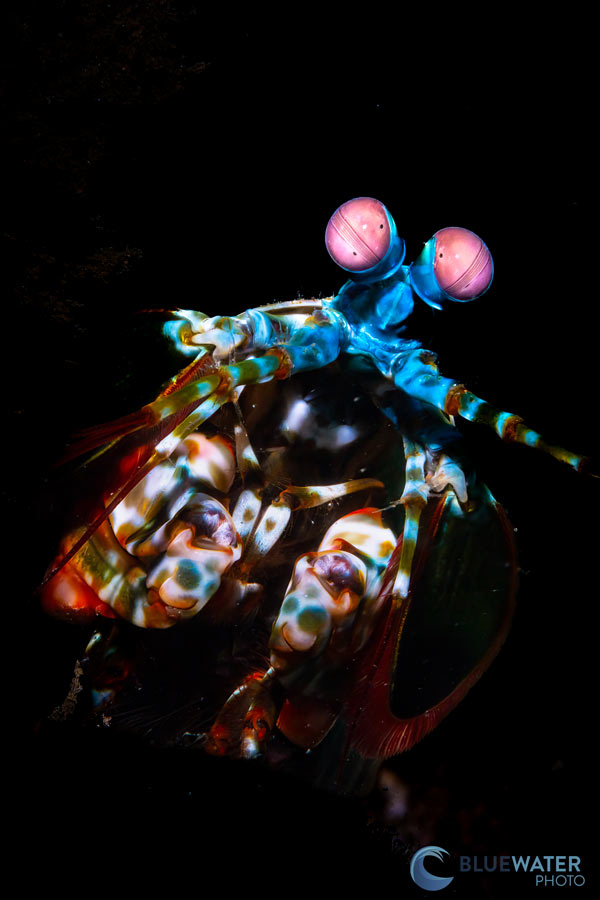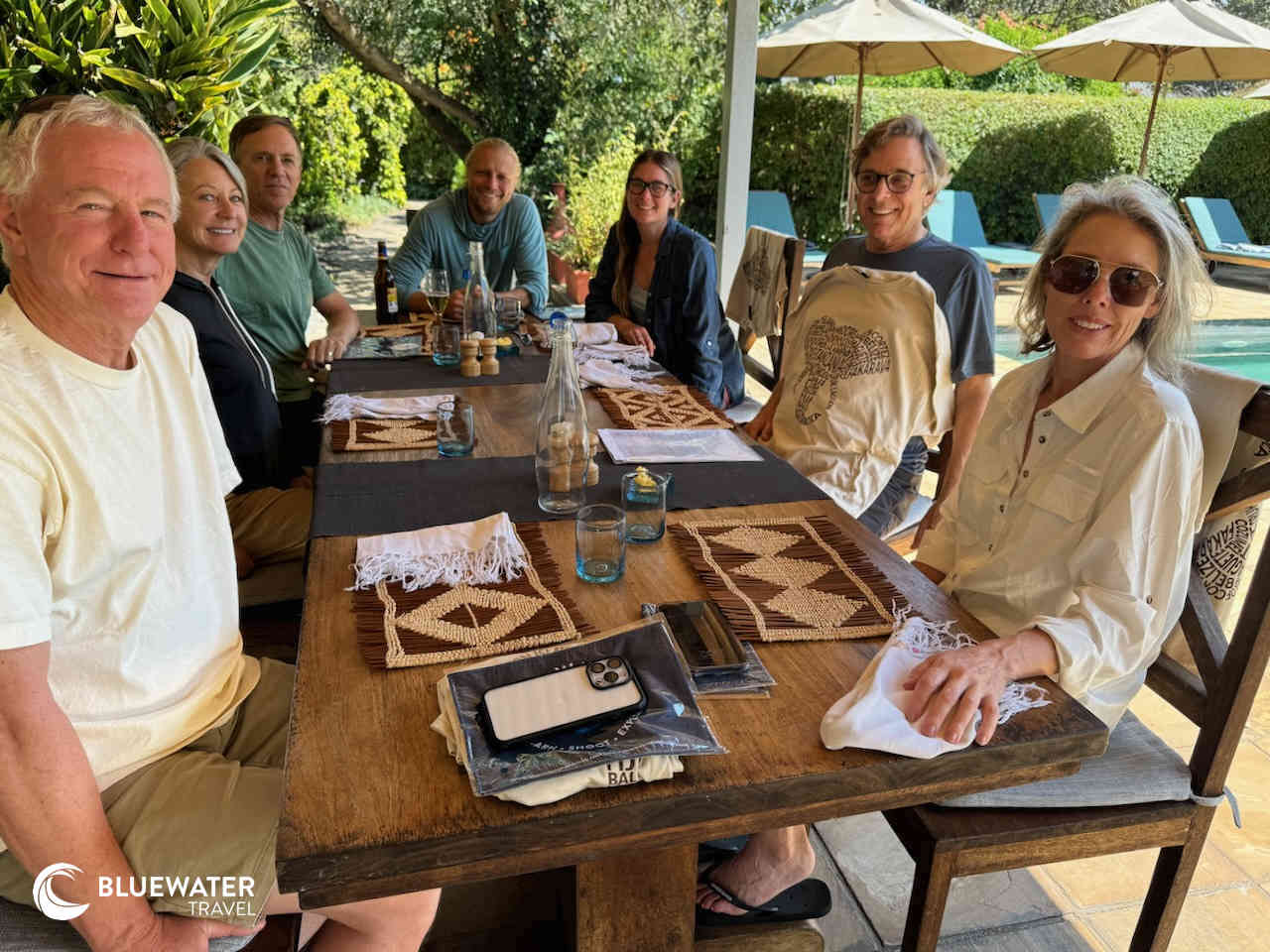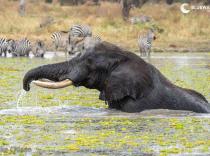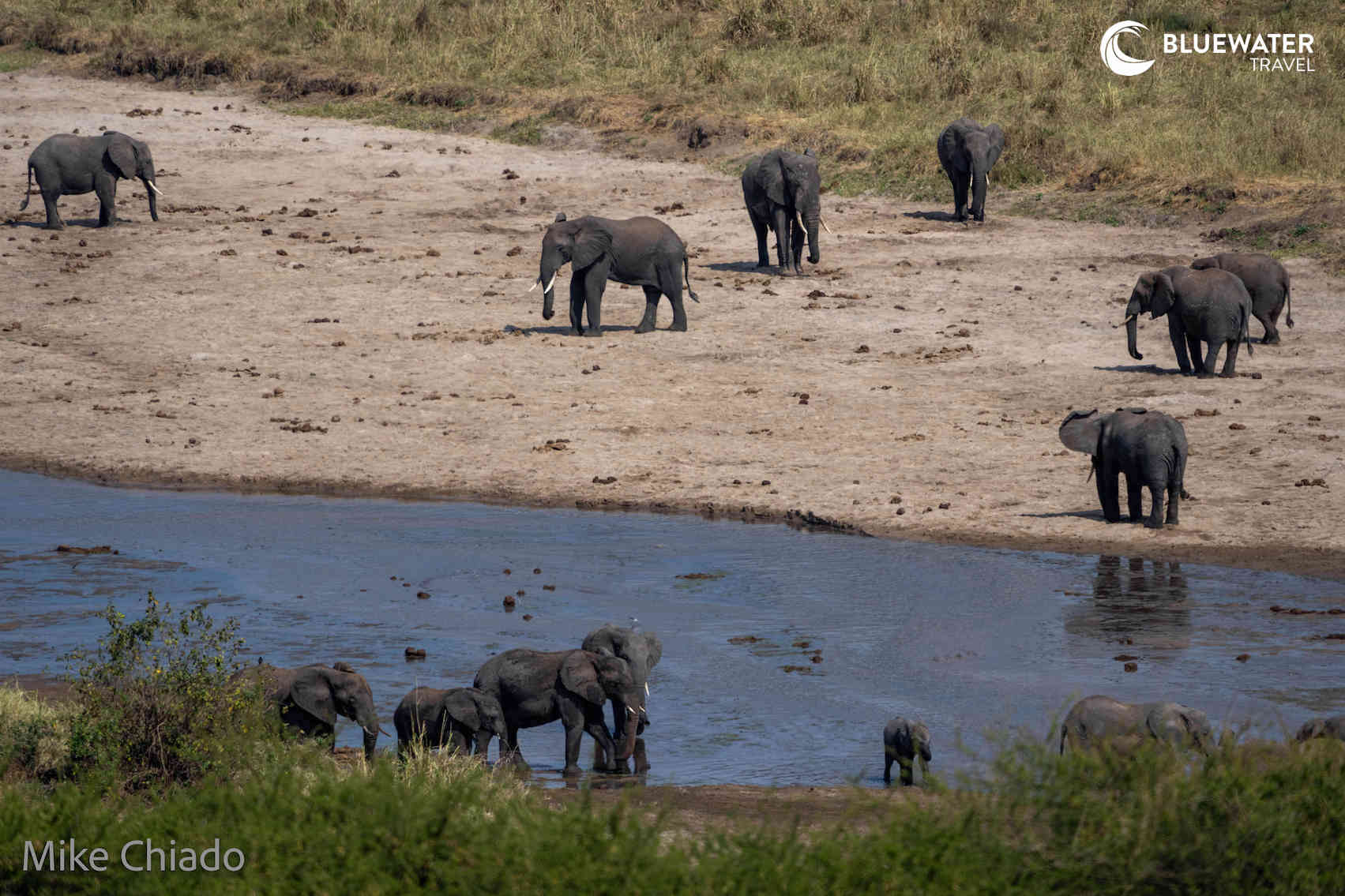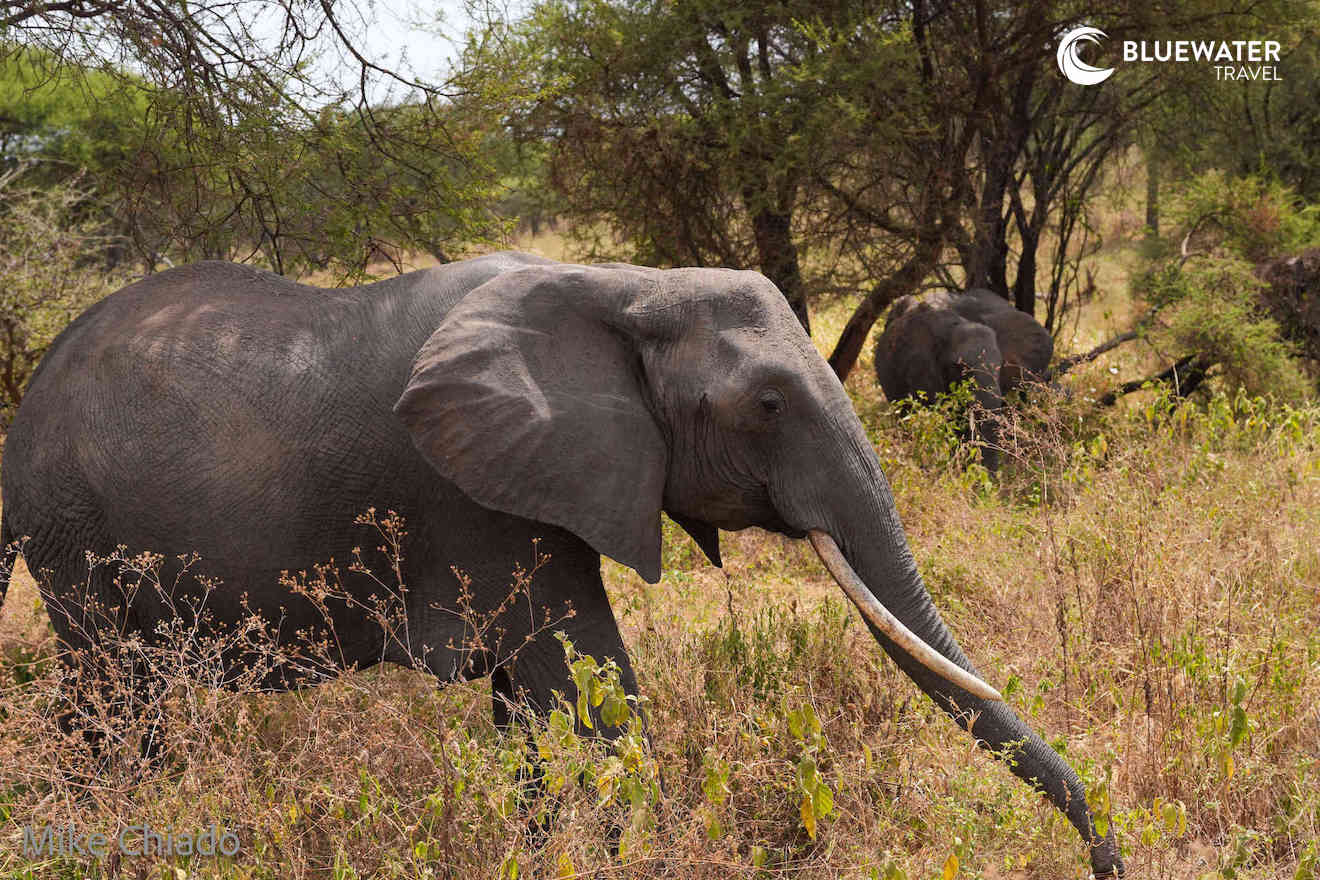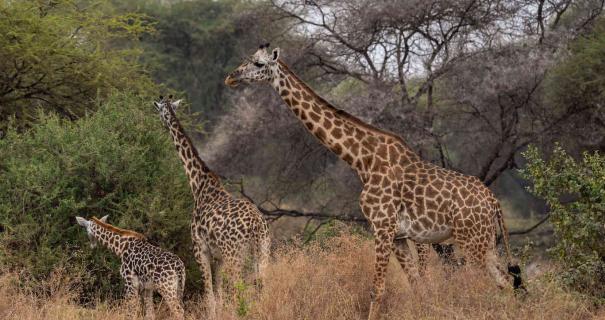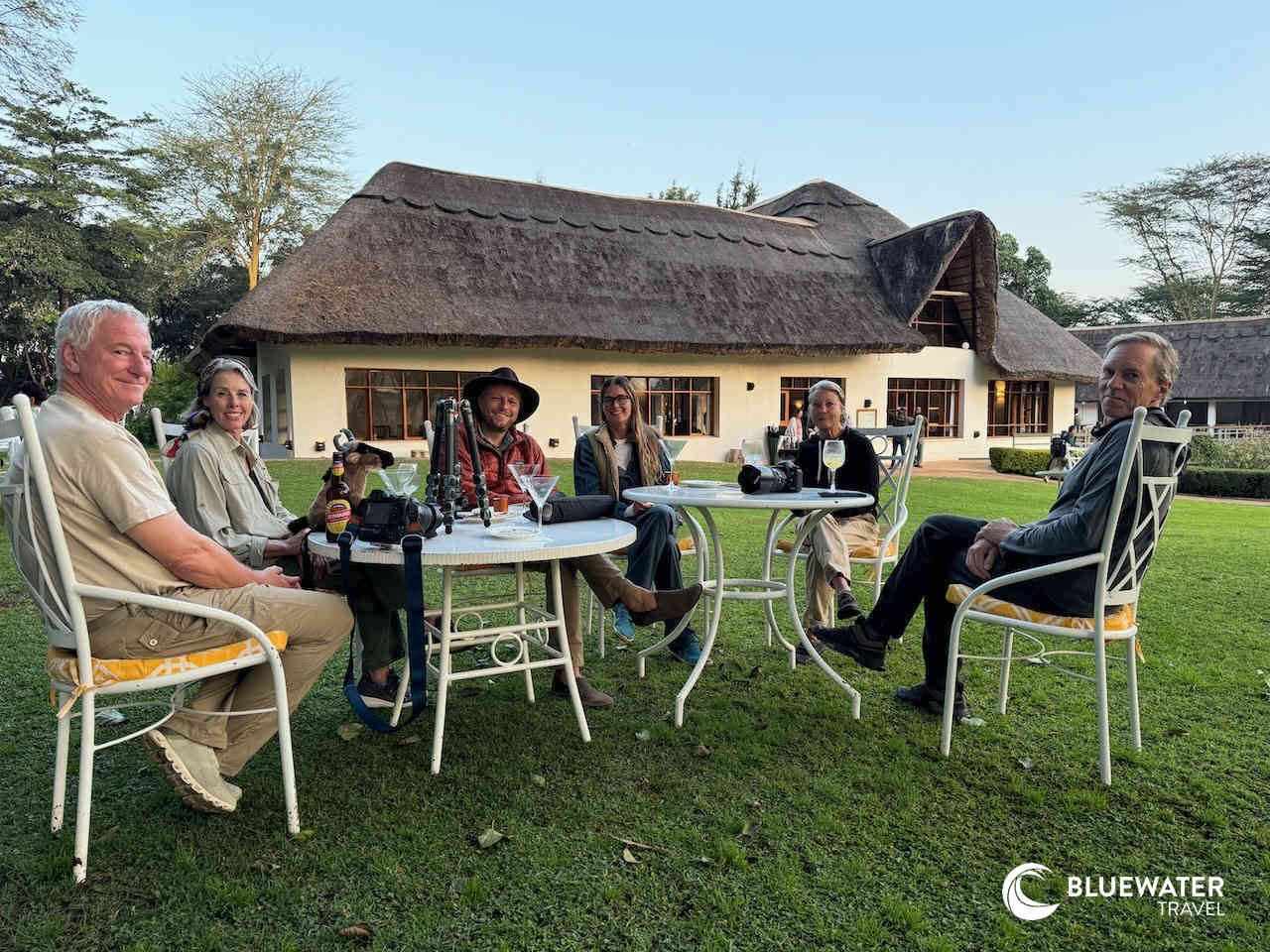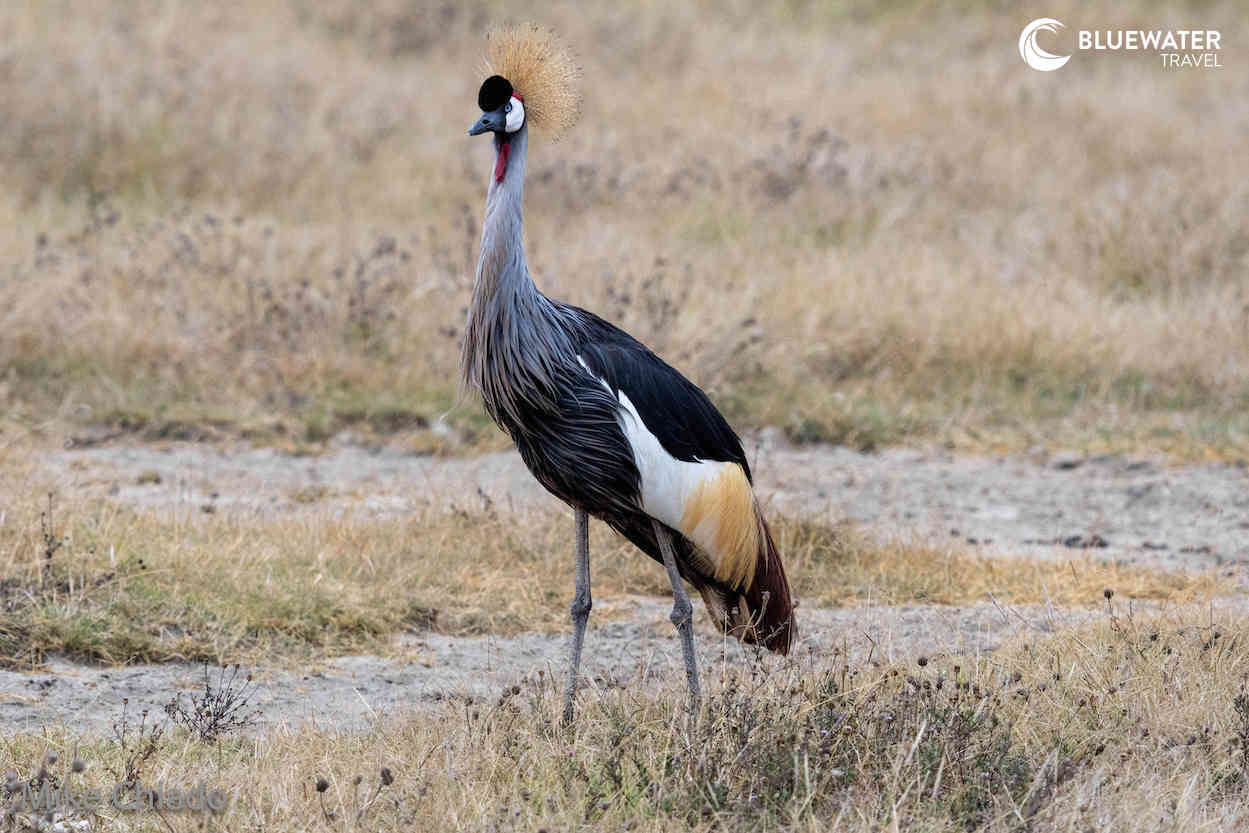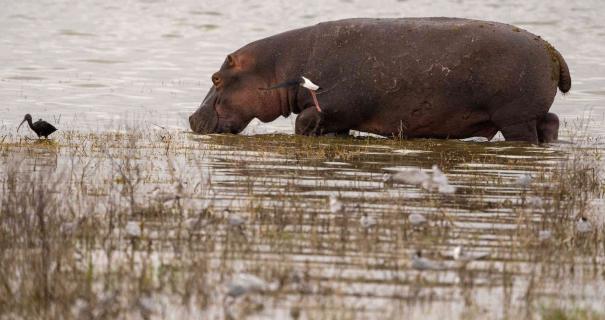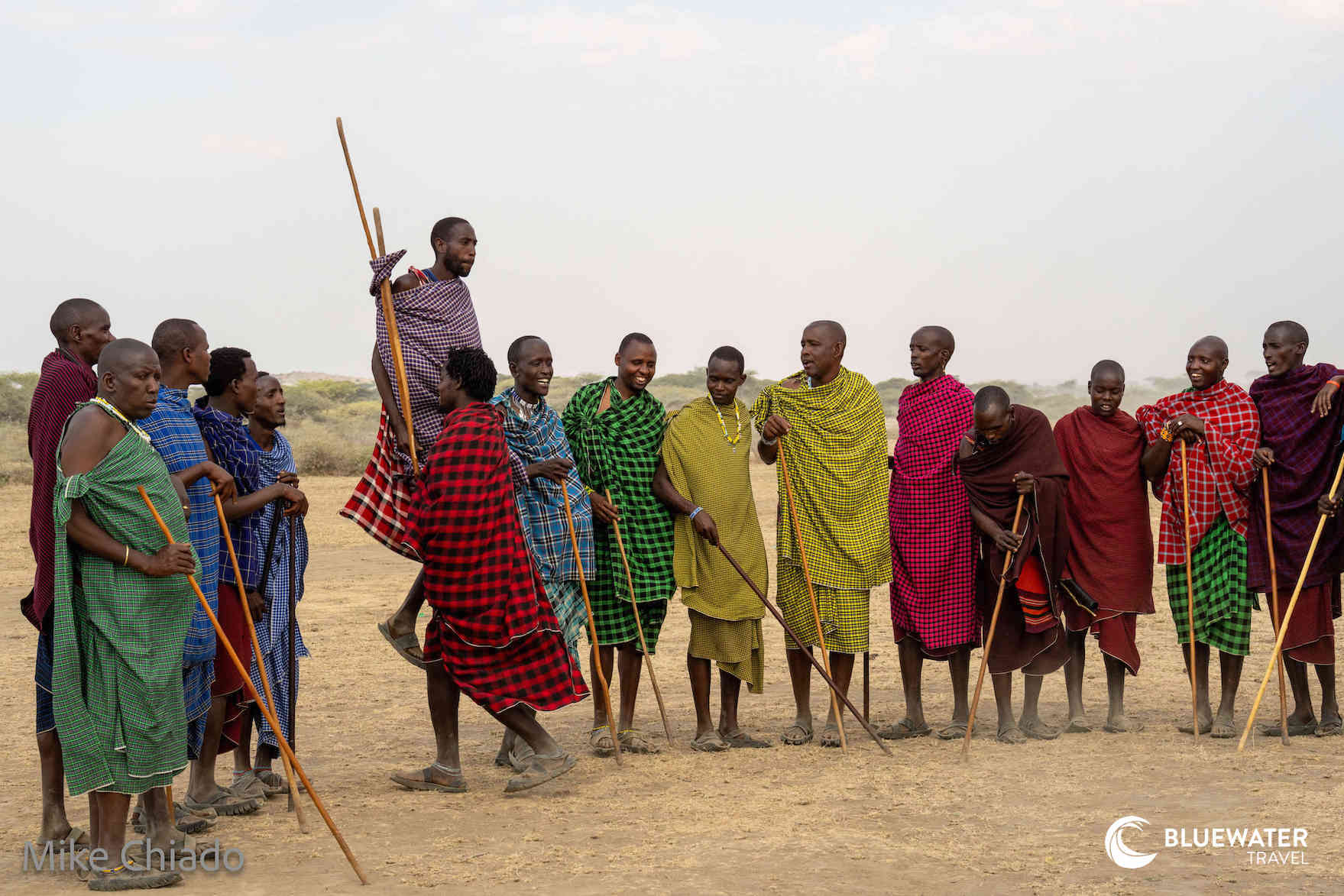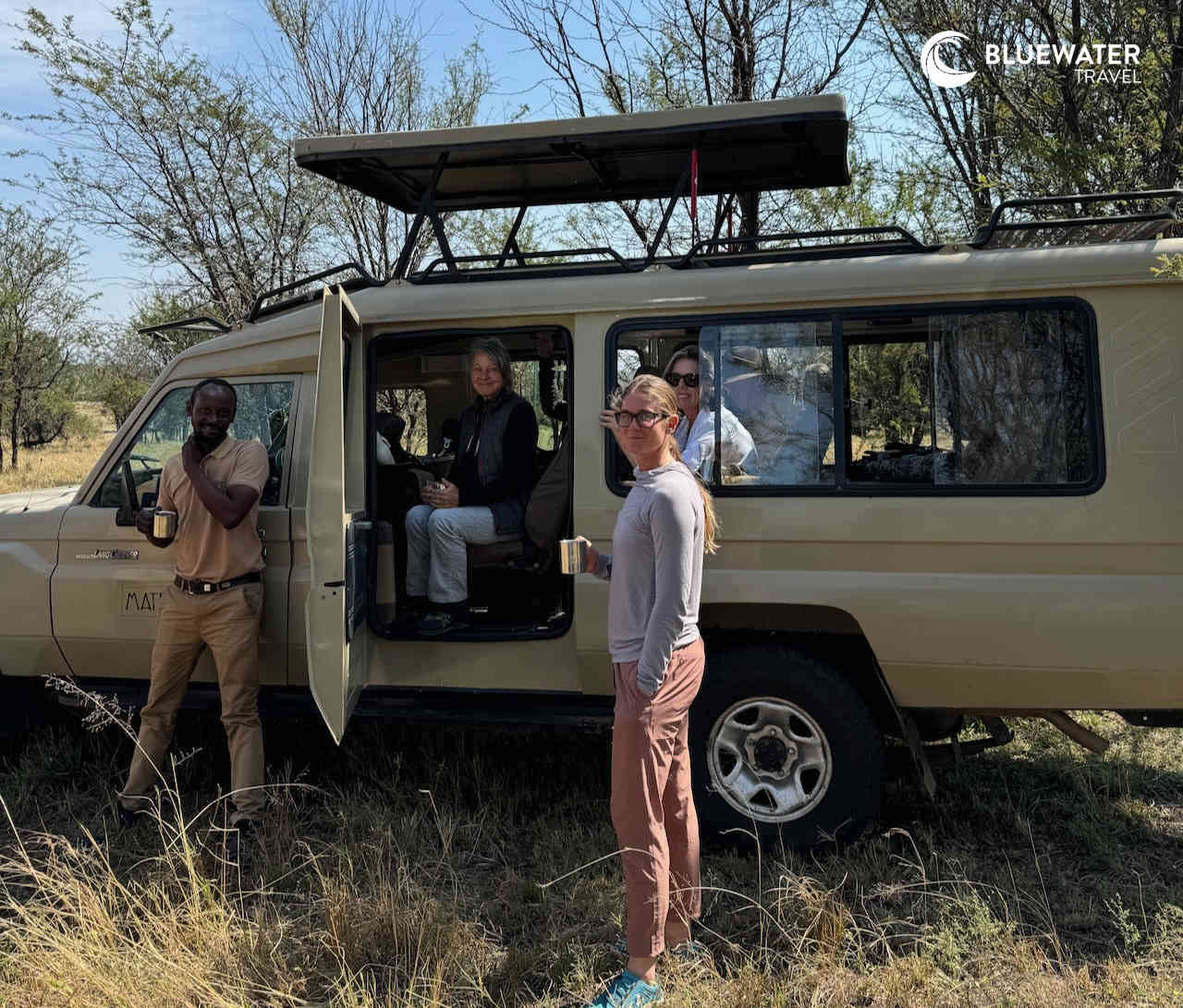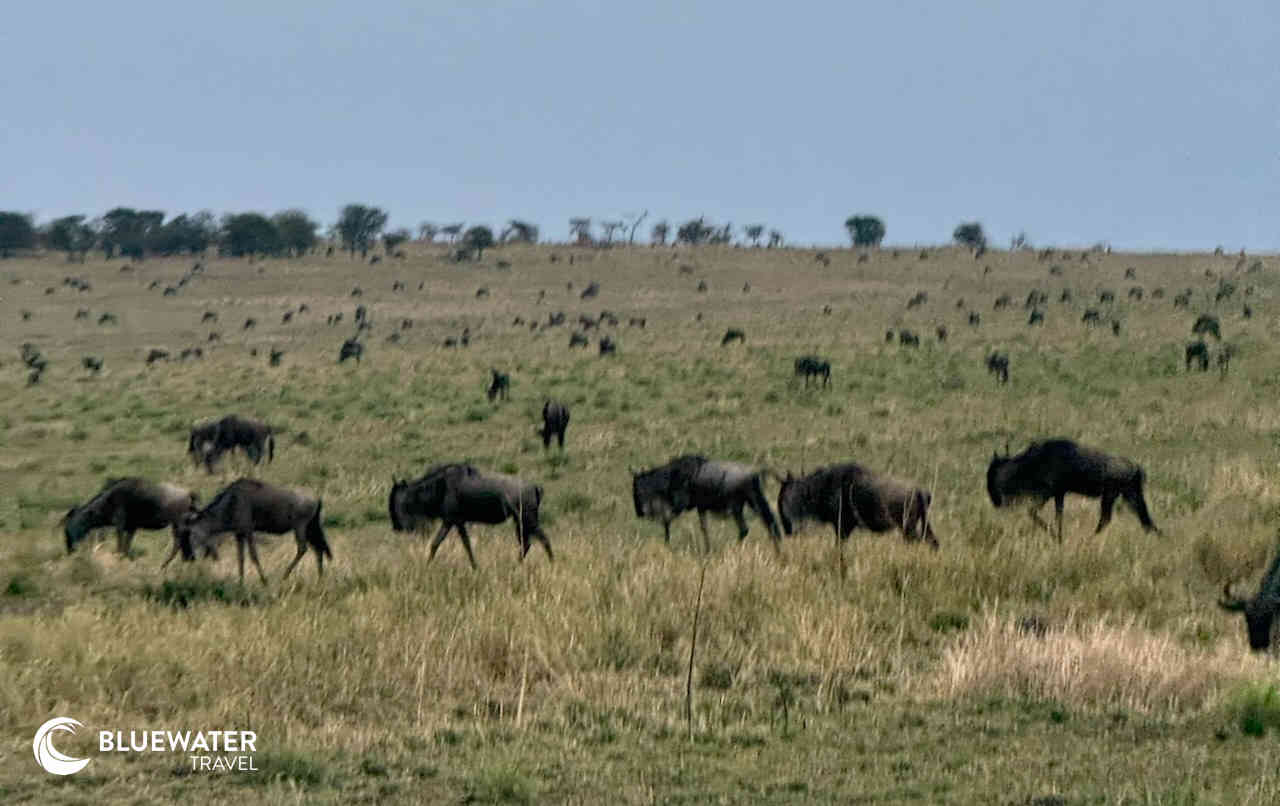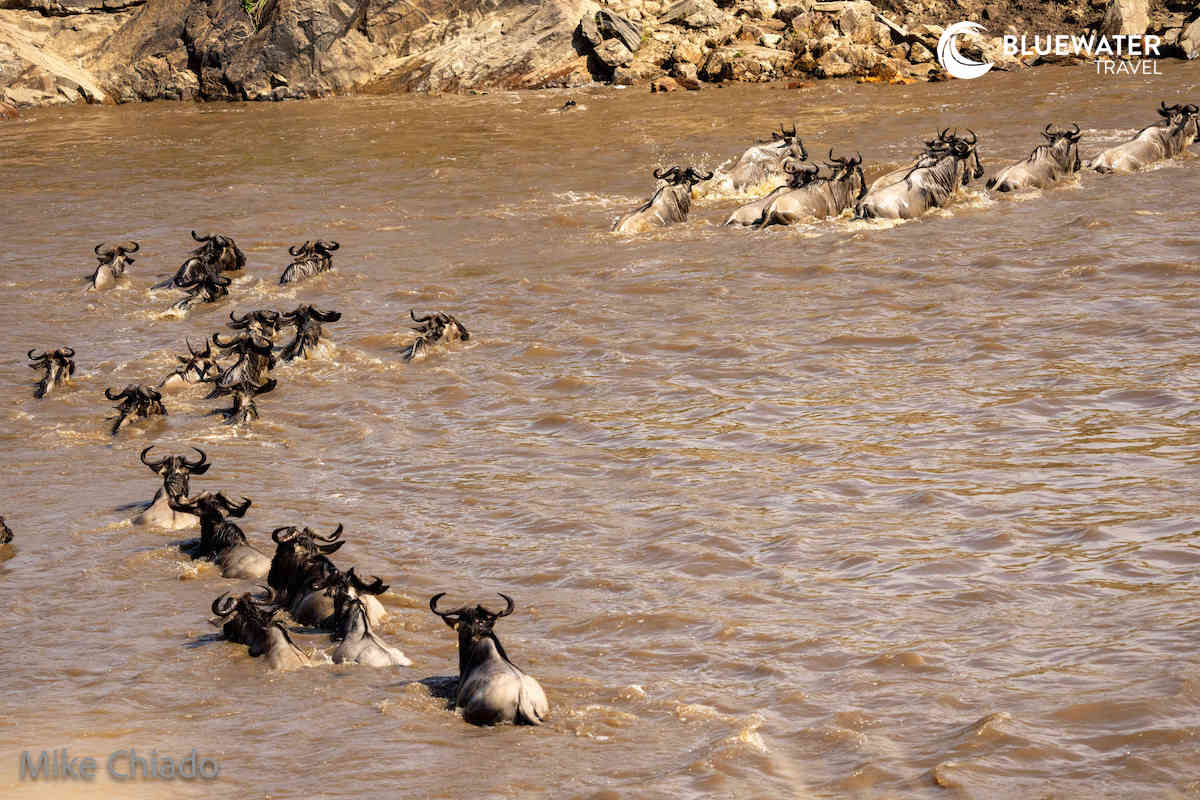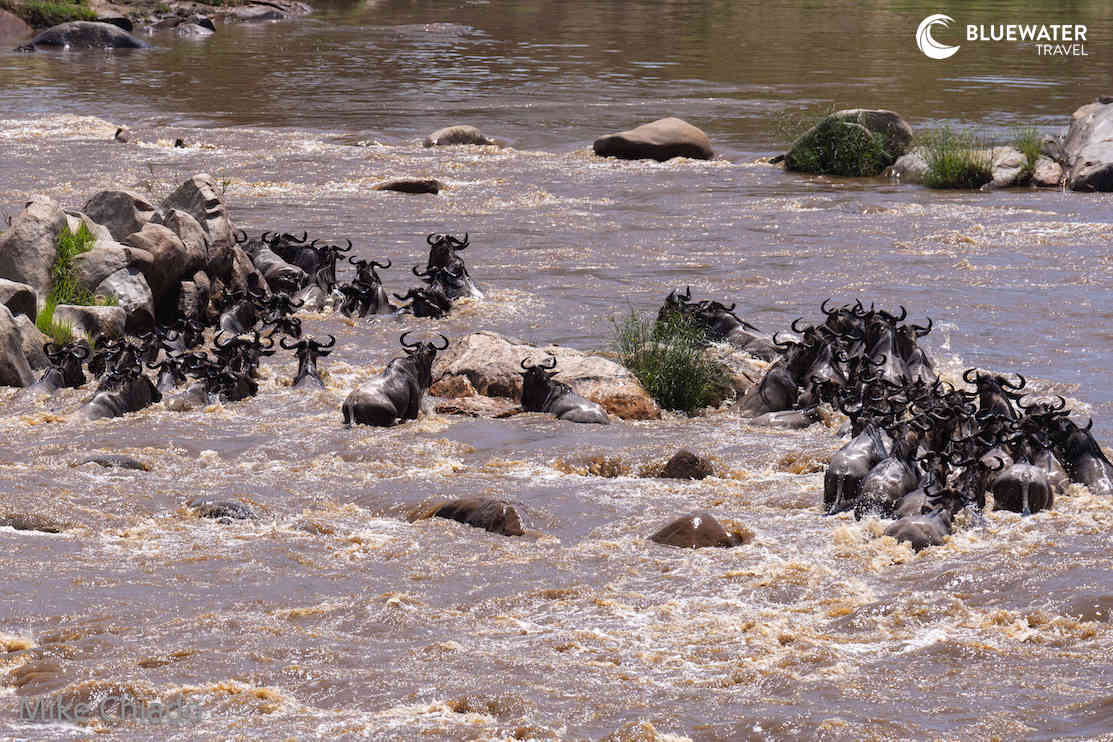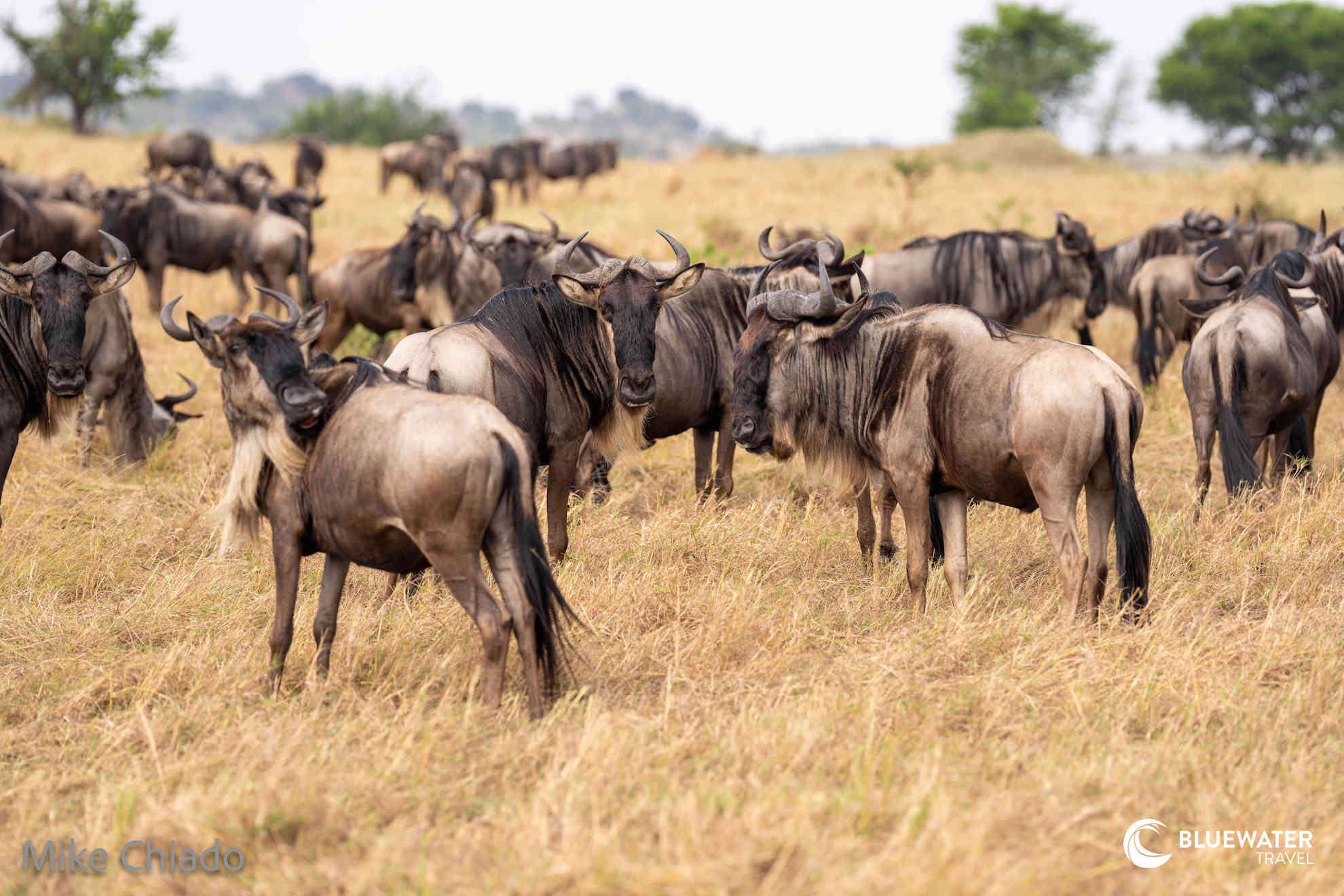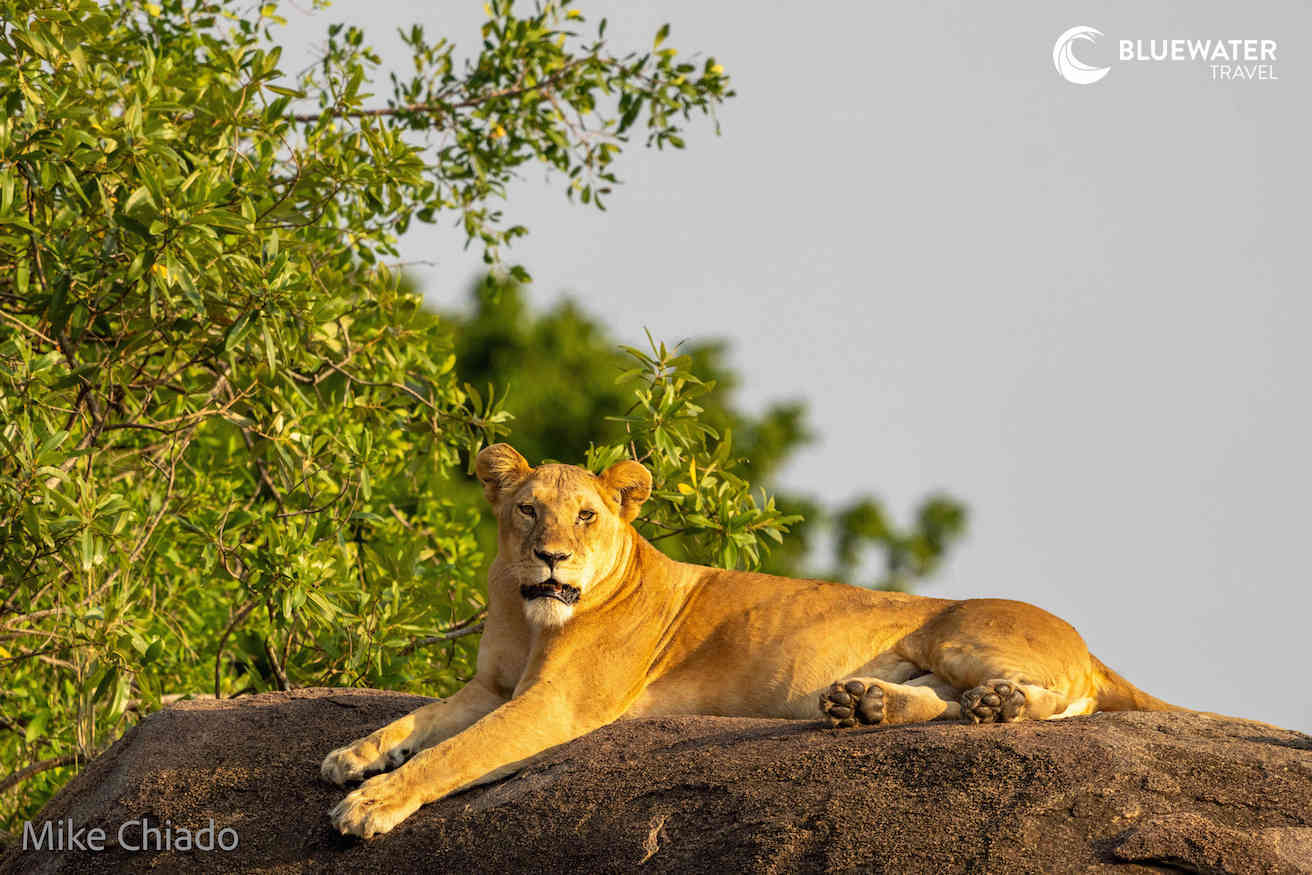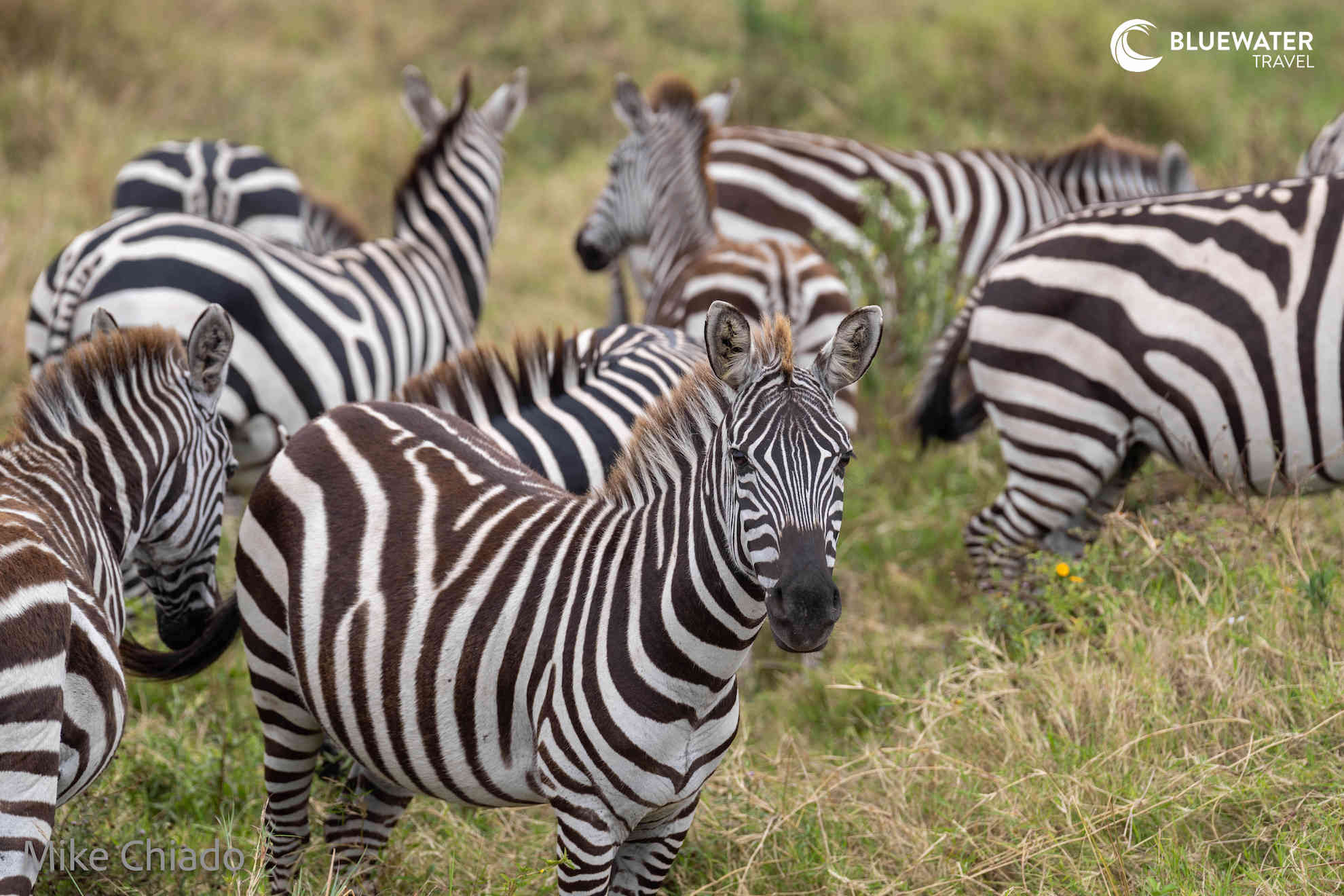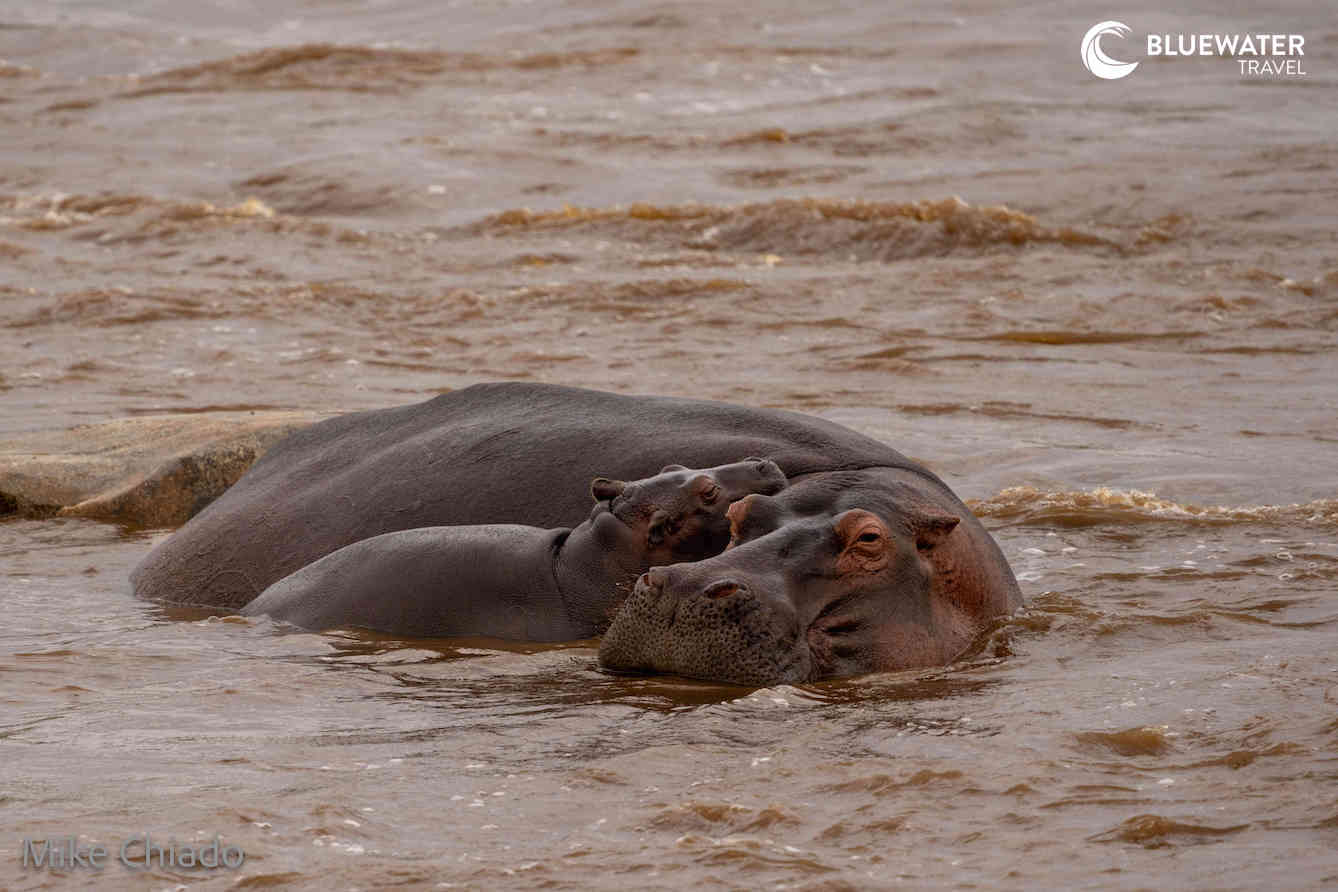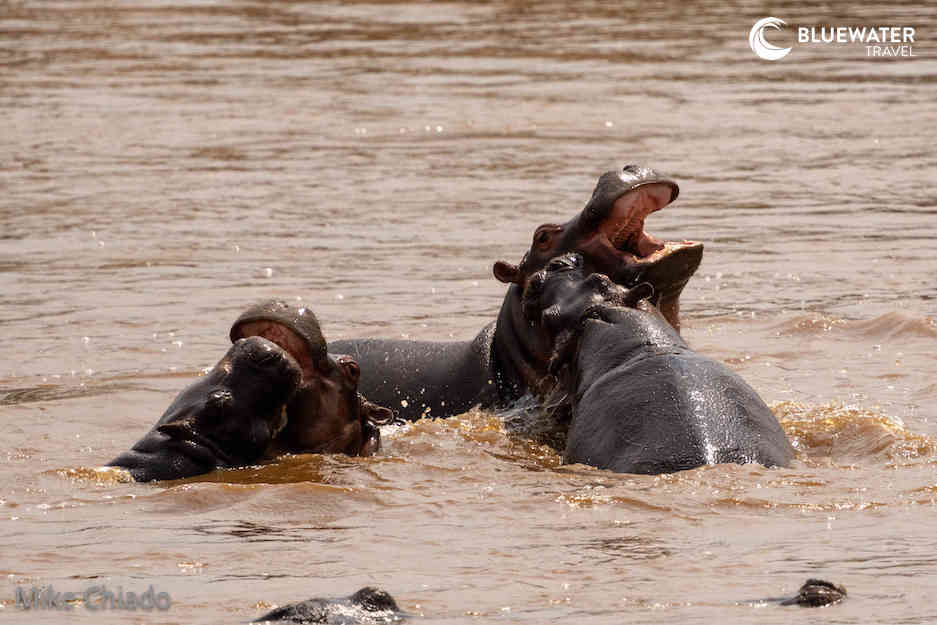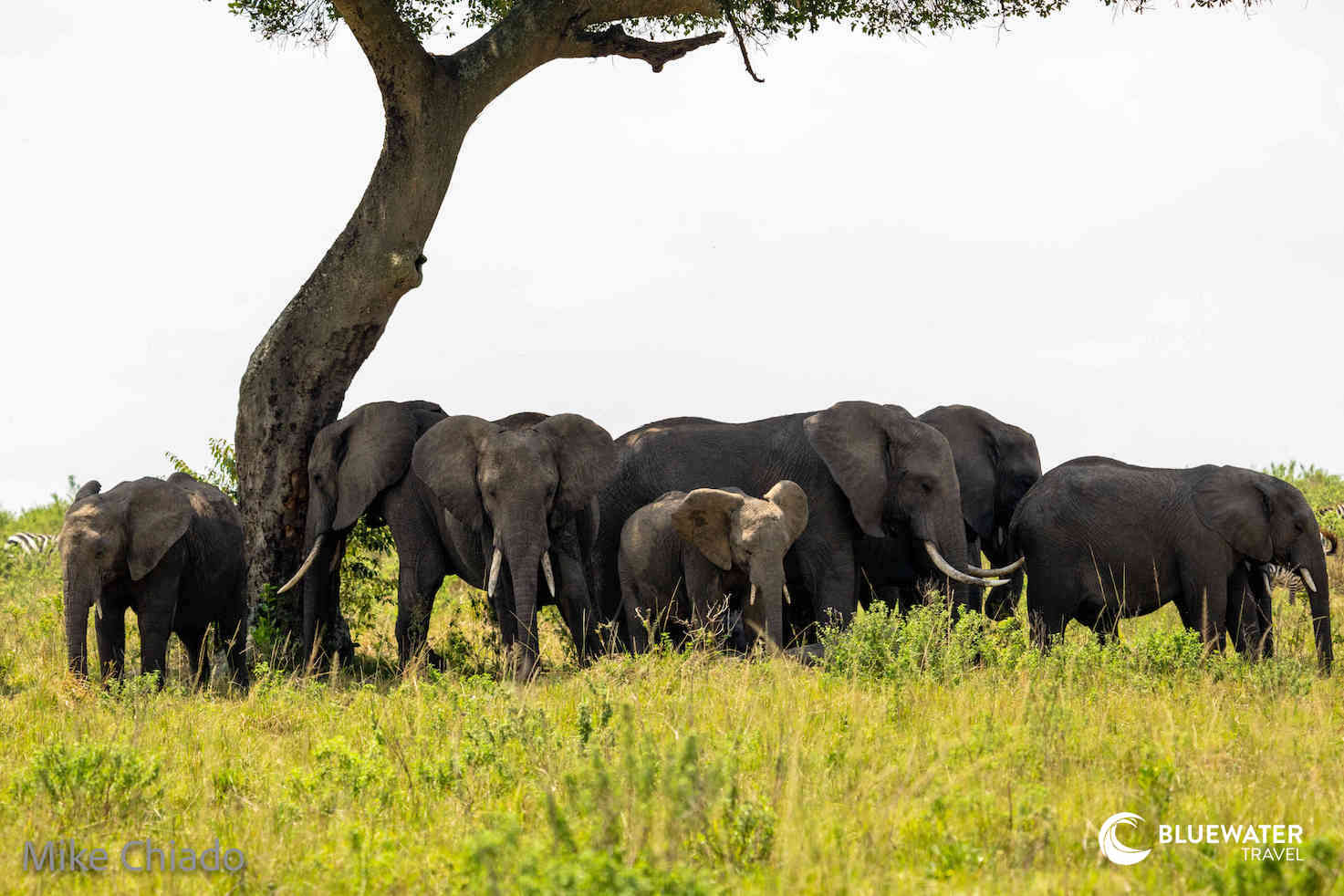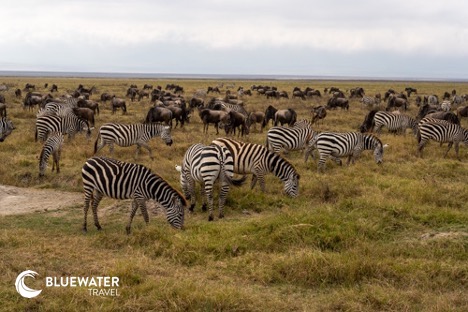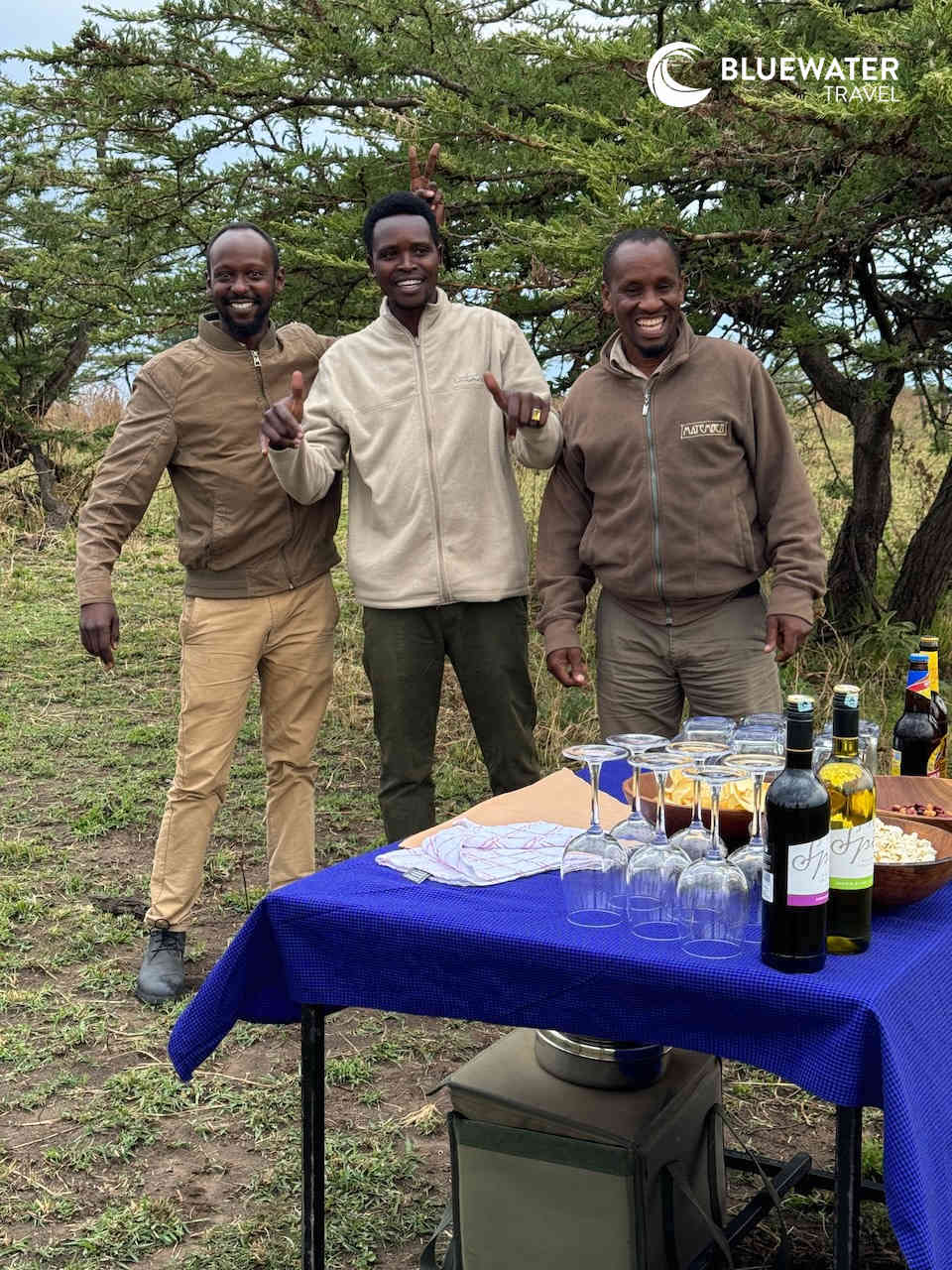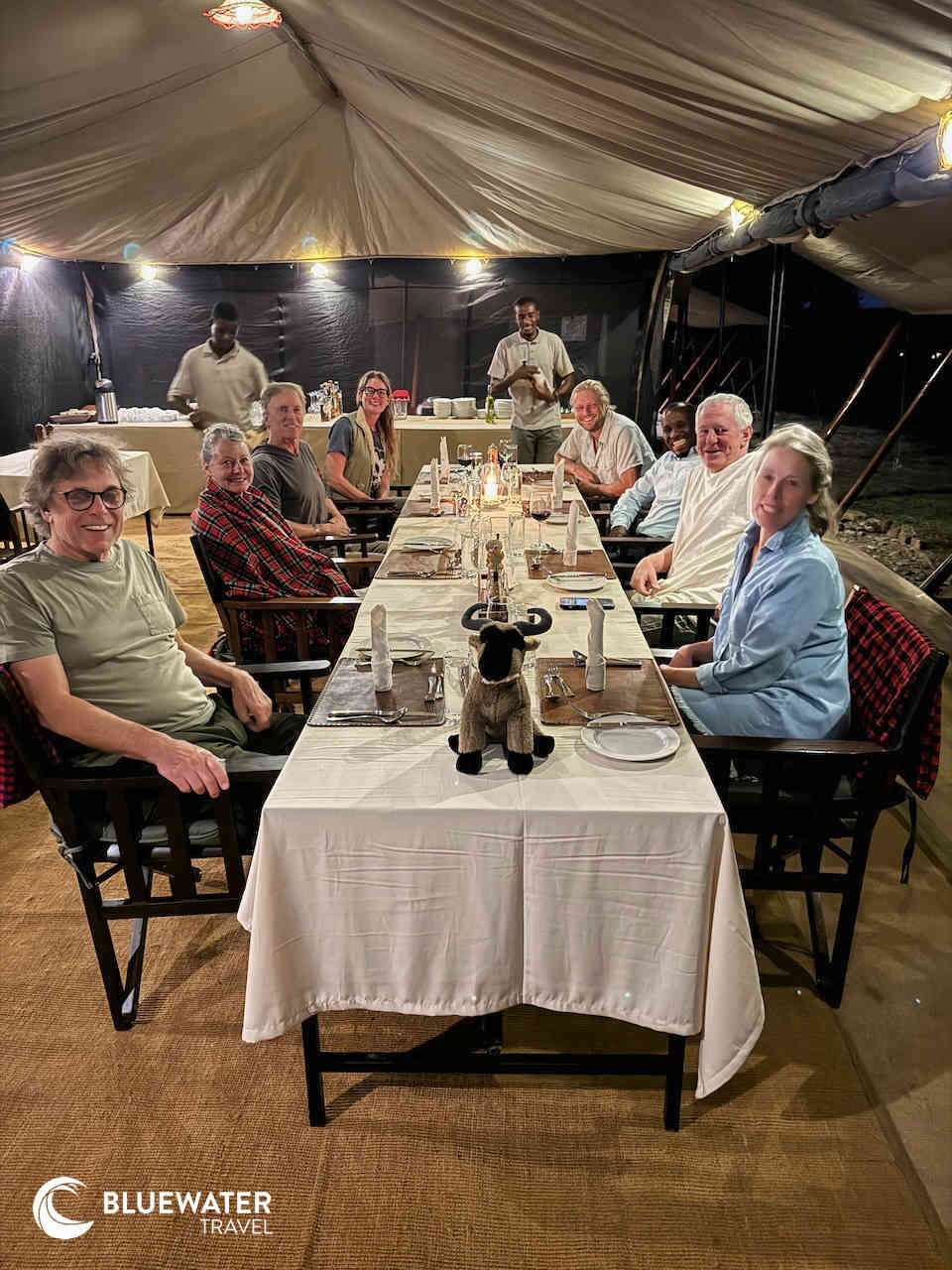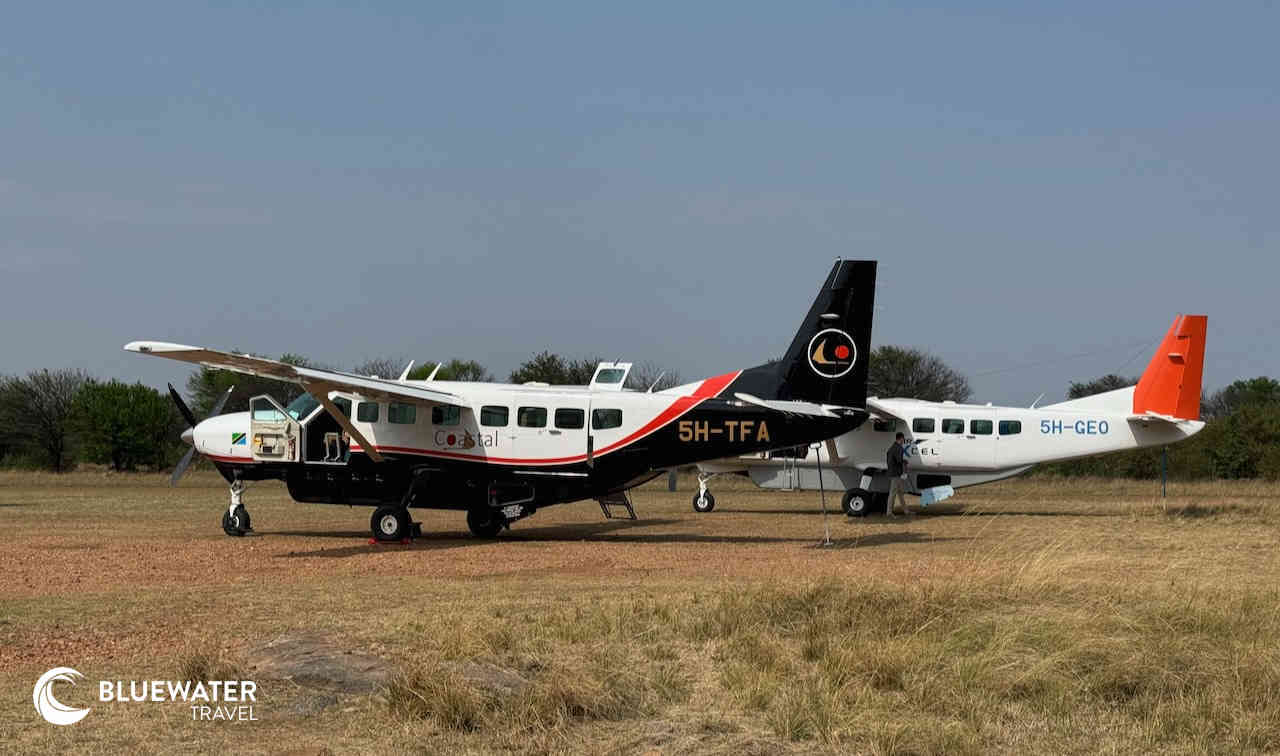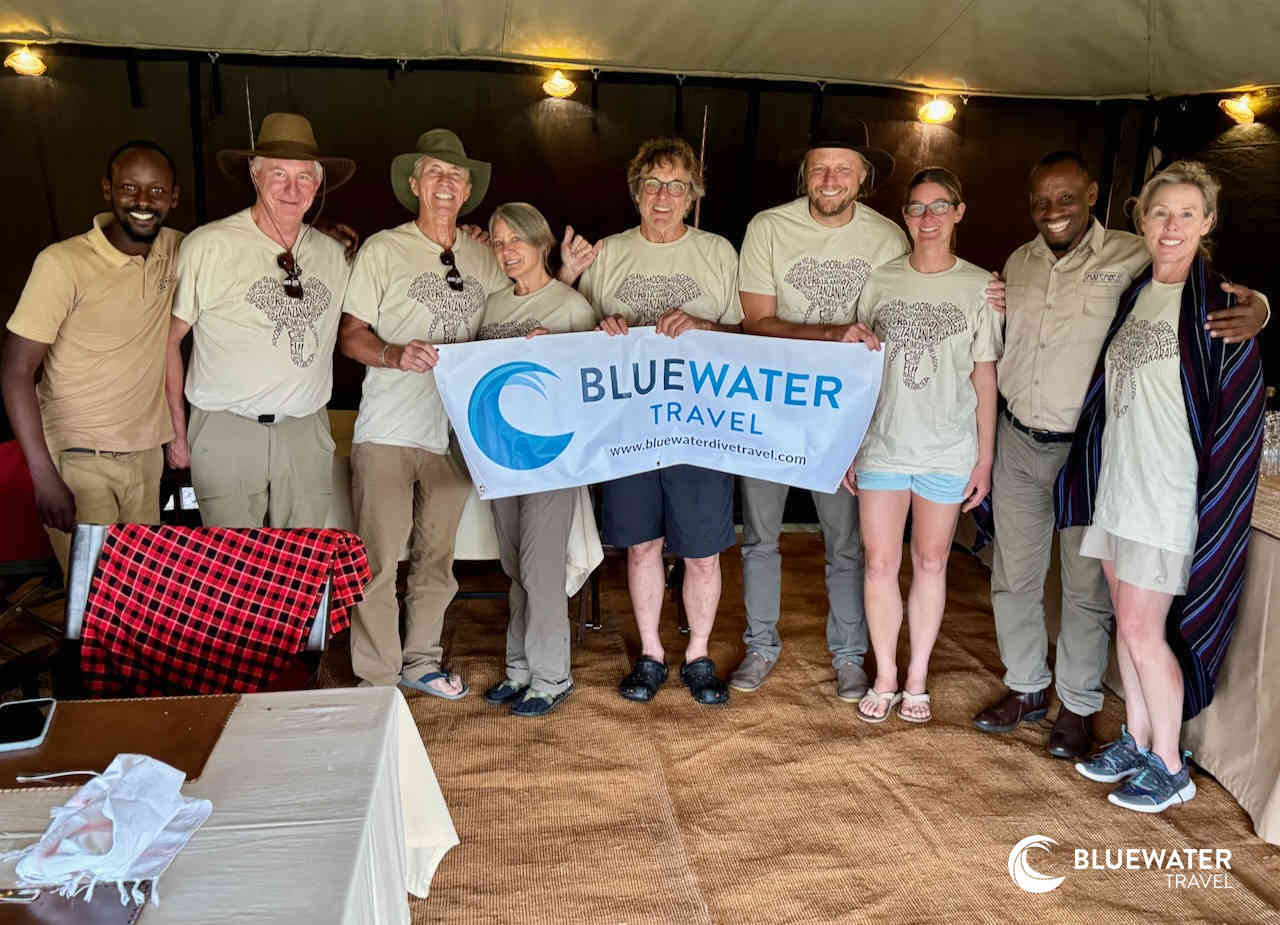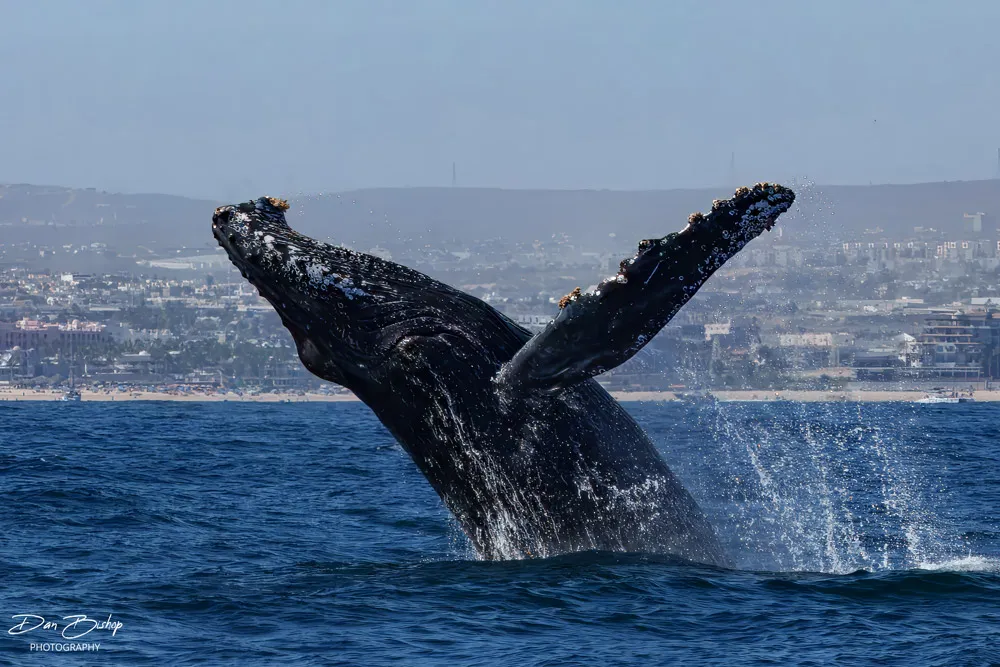Tanzania Big Game Safari Trip Report August 2024
In August 2024, Mike Chiado led a thrilling Bluewater Photo Group safari in Tanzania. They explored areas such as the Tarangire National Park with its baobab trees and wildlife, encountered a black rhino in Ngorongoro Crater, and witnessed the majestic wildebeest migration in Serengeti, ending with a memorable leopard sighting.

Bluewater Travel's Tanzania Big Game Trip Report
Tanzania Photo Trip Recap August 2024
Words And Pictures By Mike Chiado, Trip Leader
Our August Bluewater Big-5 Safari was scheduled for the peak of animal action in the Serengeti. Some of our group arrived a day early to acclimate while others arrived on the first day of safari. Regardless of the arrival, we were all gathered by the local tour company for lunch and first safari nights stay at the Katambuga House in Arusha, about a 90-minute drive west of Kilimanjaro Airport. Arusha is tourist hub of Tanzania.
The local guides that meet us in Arusha were the same ones that would be with us for the whole trip. The guides stay at the same resorts and drove the customized Toyota Land Cruisers between camps through bush for viewing and photo opportunities, and provided local knowledge of the environment, culture, and wildlife. I loved that the guides stayed with us each day to avoid the inevitable stress of new guides at each location
Here is a day-by-day recap of our amazing trip:
Day 1, August 6th
Our group assembled at the first lodge, Katambuga House, by noon. (Katambuga is a Swahili word for the shoes worn by the Maasai made from old tires). We meet for lunch and our first face-to-face introductions at 1pm in a lovely poolside dining area. Before lunch we made use of our garden-side rooms for a quick refresh.
The afternoon was left for everyone to attend to their own needs. At 6pm, we enjoyed drinks and snacks in the lodge's lobby warmed by a large fireplace. Dinner was at 7pm and received high marks. After the long travels, all retired early.
Day 2, August 7th
A group breakfast was served at 6.30am with hot items made to order plus an assortment of fruits, pastries, cereals, yogurt, and even soy milk for our vegan. At 8.30am, our transportation arrived that would be used for the remainder of the safari and take us on the two-hour drive to Tarangire National Park. Our group was split across several Land Cruisers giving everyone plenty of space for the journey. The vehicles were driven by trained professional guides that stayed with us for the whole trip. A real comfort that we didnt have to worry about drop-offs and pick-ups with new daily guides. (Sorry to repeat this, but I cant emphasis enough how great it is to have the same guides for the whole trip).
Arriving at the entry gate to Tarangire Park, a brief stop for permits was needed while the group used restrooms, shopped, and had coffee. The park is large, at 1100 sq miles, and the most southerly point in Tanazaia for our trip. All subsequent camps and lodges would be further north toward Kenya.
As we entered the park we were immediately treated to zebras, giraffes, warthogs, wildebeests, antelopes, and an elephant bathing in a pond, with zebra, antelope and wildebeests on the far shore. What a start! Being our first elephant encounter, looking back we spent far too much time at that location. Around 1pm, we stopped for lunch in the bush to eat what had been packed by the Katambuga House. More sightings of the same followed lunch before arriving at Tarangire Safari Lodge located inside the park proper.
After checking in, we rested in our tents. The tents are permanent fixtures with electricity, flush toilets, and running water for the shower and sink. The Lodge overlooks a river valley frequented by all sorts of wildlife, and of special note is a herd of elephants that made a daily trek by the lodge to and from the river to the highland feeding grounds.
Before dinner, we had a late afternoon drive in our Land Cruisers. Not far from the lodge, an elephant herd paraded right by our jeeps and we also spotted a pair of cheetahs, calm enough that we were able to approach very closely as they rested. A great day in everyone's opinion.
A word about safety. Most of the trip is spent in underdeveloped areas full of wildlife. The areas are National Parks or Conservation Areas and are gigantic in size. All wildlife interactions are from the safety of a rugged Toyota Land Cruiser outfitted for the purpose of wildlife viewing and photography. The only time guests are outside of the vehicle in the bush is for bathroom breaks or meals, and then only after the guides determine the area is safe. While in camp, venturing outside of the tents at night is allowed only with supervision. Youre taught how to use lights to summon an escort. In other words, yes, there are lions roaming around, but tourist safety is well thought out for every situation.
Day 3, August 8th
We left before dawn for the days game drive (game drive = wildlife viewing from a jeep). Elephants, zebras, a pair of lions, a leopard, impalas, and much more, and all before lunch! Before departing the lodge after breakfast, each of us visited a buffet to make lunch selections that were then boxed for take-away. We ate lunch at a swamp in the southeast part of the park. After 7 hours in the jeep, we returned to the lodge for a rest. Photo processing help was offered in the lodges lobby bar from 3-5pm before the dinner buffet at 7pm. The Lodge always provided a table for seating our group so no one was left out.
The day was not over, a night drive started at 7.30pm with sightings including some creatures not seen during the day - mongoose, fox, bush babies, owl, eland, genet, ostrich, leopard, spring hare, civet, and jackal. An interesting note is the bush baby is smallest primate, and named not for their tiny size, but for the sound they make which is just like a crying baby. The crying sound is startling at first, coming from the bush at night. The photographic opportunities at night were limited, often with creatures dashing away from the light, but still provided glimpses of some creatures that we would not have seen any other way.
Exhausted, we headed off to bed after the 2+ hour night drive.
Day 4, August 9th
The day started with an early breakfast at the Tarangire Lodge. To get an early jump on the day, the group met when breakfast service started at 6.30am. Each of us then assembled our own lunch from a buffet which was nicely boxed up by the lodges staff. The morning drive sightings were slow paced but picked up with giraffes and zebra grazing together for a super photogenic opportunity. All guests were delighted with the mornings sightings and our final hours in Tarangire.
Our two vehicles met at the Tarangire Park gate on the way out of the park to allow for a leg stretch and coffee. The next stop was the Ngorongoro Conservation Area to explore an area call the Crater, which is actually a caldera and the worlds largest intact volcanic caldera. The journey to Ngorongoro went smoothly with a stop at a high-end shopping mecca that also provided tables for tourists like us to enjoy our boxed lunches. The shopping was African products and antiques from super expensive to affordable. Looking back at the shopping, this stop was the best opportunity for gifts and souvenirs we encountered.
Continuing on, we arrived at our next lodge, the spectacular Ngorongoro Farm House, by mid-afternoon. Some of us took advantage of a tour offered of the grounds seeing some of the nine acres of coffee plants and seven acres of vegetables and fruits. Everything served in the restaurant is sourced from the gardens.
Our group met for happy hour and continued with dinner on the outside patio with stunning views of the sunset.
The lodge kindly did our laundry as an express service at no additional change and returned out clothes in just a few hours. (They washed ladies underwear, too. Something we were forewarned might be an issue.)
Day 5, August 10th
5.45am and everyone was up for an early breakfast at the Farm House. The staff came in early to serve us before their usual 6am opening - very kind of them. The breakfast offerings were many and led to a slight delay in our departure time! As we had already experienced, lunch was a buffet and sandwich bar where staff would pack individual boxes for each person.
At 6.20am we left the Farm House for Ngorongoro Conservation Area (NCA). Upon arrival at the NCA, our guides retrieved our permits for entry while we stretched our legs. With permits in hand, our jeeps headed up to the crater rim and then descended to the crater floor. Right away we spotted hippos and pink flamingos, and the sightings continued with a super tusker elephant, lions, gazelles, zebras, wildebeests, great white pelicans, gray crowned cranes, coots, egrets, secretarybirds...Wow!
Our group departed the crater after eating our Farm House prepared boxed lunches. On the way to the next lodge, our group elected a slight detour to visit the Maasai Culture Center. The cost was $50/car and we toured a Maasai village that included entering a sleeping hut, school, and community area. Crafts produced by the village were for sale and prices negotiated strictly with the village women. On departure, the whole village treated us to exuberant dancing and singing show. The Maasai men showed off their jumping ability as part of the dance.
At 5.30pm we arrived at the next camp, Lake Masek Tented Lodge. The accommodations are semi-permanent tents, much like those at Tarangire National Park from earlier in the trip. The plumbing and electricity are permanently affixed for en suite flush toilets, sinks, and showers, and there are also lighting and device charging points. Dinner was great for all, but difficult for our vegan as the local chef used beef to flavor the dishes. This was the only issue for encountered the whole trip.
One guest discovered that they had left their laptop at the Farm House. We coordinated for returning the laptop through our guide and the camp staff and the laptop met us on the last day of the trip in Arusha.
Day 6, August 11th
We had another early breakfast as we departed from Lake Masek. The morning was spent driving around Ngorongoro and South Serengeti grass lands, zigzagging between, with a stop for lunch at the Serengeti entrance gate.
Overall, we spent nearly 12-hours on the safari drive! The day presented us with cats, cats, and cats - four male lions relaxing, a solo female lion, two pregnant female lions, a female lion with two cubs, a cheetah with cub, plus giraffes, hyenas, hippos, gazelles, impalas, topis, hartebeest, and wildebeest... constant photographic opportunities!
At 6.30pm we arrived at Kati Kati Tented Lodge - another semi-permanent tent camp. Dinner was served shortly after by the camp and was the now usual multi-course high standard with wine and white table clothes. Our group was very satisfied with drives, guides, wildlife encounters, meals, and great service.
Day 7, August 12th
After breakfast at Camp Kati Kati we departed early with all our luggage. We spent the morning searching for black rhino but with no luck. We had to settle for giraffes, baboons, ostriches, hyena, zebra, wildebeests, lions, caracal, impala, gazelles, dik-dik (tiny cute antelope), and hippo. Our lunch stop was a shady spot in the bush with fresh coffee made by our guides.
After lunch we left the Central Serengeti and headed to the northern part. The drive was around 4 hours to the next and final camp site in the bush.
We arrived at Esirai Migration Camp Northern Serengeti just before dinner. This camp is different than the previouse ones, as hinted at by the name containing the word migration. A camp like Esirai follows the wildebeest migration and moves as the herd moves. The other camps were semi-permanent with plumbing and electricity in the tents. Esairai, being mobile, outfits each tent with a fancy pit toilet (a bucket of sand and scoop are provided to cover the waste, ala, kitty litter), gravity fed sink and shower, and solar powered lighting. Showers required asking camp staff to fill the shower feed with hot water, and it is very hot! Also, electricity for charging our gear was available only in the library tent, aka, the covered place to relax. Day to day activities at the camp were easily coordinated and started with coffee delivered to our tents pre-dawn before breakfast. During the morning coffee handoff, or the night before, requests were placed for hot showers. The camp staff are extremely service-oriented and caters to our every need. The days ended with a campfire to unwind and reflect upon the day.
Day 8, August 13th
Coffee was delivered to everyone's tent with cookies and even soy milk, on request. This was followed by an early breakfast with eggs cooked to order, plus the usual bread, fruit, and potatoes.
At 6.15am, our group loaded into their Land Cruisers and headed toward the Mara River to hopefully witness a wildebeest migration crossing and our first views of the Northern Serengeti. The wildebeest (aka gnu) herd size is estimated at 1.5 million.
At 8am we arrived at Mara River to find wildebeests everywhere - as far as the eye could see. The start of a crossing evet is seemingly at random. One wildebeest just starts running, then others start running, following the instigator. The rush of wildebeests may cross the river, or just as quickly, stop and start grazing again.
Mid-morning, the charge of wildebeests started and crossed the Mara River right in front of one our jeeps! An amazing event to witness - gnu jumping off high riverbanks, landing like a cannonball in the water, submerged to their necks as they slowly moved to the opposite bank, one after another and another and another The second jeep, unfortunately, didn't have a good viewing position for this first crossing. The location was Point 4, in the middle of the favored paths of the wildebeests - numbered from one to ten. We later learned that we were the first group of the season to witness the wildebeest crossing the Mara River. The group crossing suffered two losses due to the massive Nile crocodiles lurking in the waters.
We waited another 3.5 hours for the next burst of wildebeests, but no luck. We needed a break and sought a shady spot with a view of the river for lunch.
To better our chances to witness another crossing, the guides recommended moving to Point 1. Well, no luck at Point 1 either.
Since a second wildebeest crossing group never assembled, and the likelihood of a later afternoon crossing small, we started the 90-minute drive back to camp around 4.30pm. All tours must be at their camps before sunset as any touring after dark is prohibited and helps rangers spot poachers in the park.
We enjoyed another fantastic dinner and the camp staff mentioned that guests last week were never able to witness a wildebeest crossing. We were very lucky to be treated to this amazing event within first few hours of arriving at the Mara River.
Day 9, August 14
Determined to see another river crossing, we started with an earlier coffee delivery to everyone's tent. Breakfast was ready for the group at 5.30am, with hot meals that had been ordered the night before. The jeeps departed the Esirai Migration Camp at 6am and during the drive to the Mara River we encountered large numbers of wildebeests with a sprinkling of zebras.
We arrived at Mara River crossing Point 1 to find many wildebeests assembled. Constant attention was paid to the herd for any sign of one wildebeest to start the charge to the river. By 10am there was no movement, so we opted for a coffee break in the bush.
Our patience paid off around noon when we witnessed our second wildebeest crossing of the trip! What an amazing event to encounter - hundreds, if not thousands, of wildebeests jumping from the riverbank into the water, swimming across and bolting up the opposite riverbank! Luckily, both of our jeeps had prime viewing positions for the crossing this time. There were no crocs to be seen and all wildebeests made it safely across the Mara River. Some guests took amazing shots of the massive wildebeests caught mid-air after leaving the riverbank.
A break was needed after the intensity of the crossing and lunch was taken in the bush with food prepared by the camp's cook. Super yummy.
The remainder of the afternoon was spent in game drive mode with sightings of southern ground hornbill birds, tiny and super cute antelopes called steinboks, plus the usual giraffes, zebras, and impalas.
We arrived back at camp at 4,45pm and the group was very satisfied with our 10-hours in the Serengeti Park. With the earlier arrival back to camp, time was available for a shower, photo review, cocktails and relaxation before dinner. A very welcomed break.
Day 10, August 15
Our final full day on safari started with pre-dawn coffee delivery to everyone's tent before breakfast.
At 6.am the Land Cruisers departed for game drive - no breakfast at camp today. Instead, breakfast was in the bush.
We passed through two massive wildebeest herds moving away from the river and towards he south. It is assumed the grasses are still good south of the Mara River due to this years heavy rains creating less pressure for the wildebeests to move north.
Close to the road, two trees full of baboons were just starting to stir as we drove past. The baboons sleep in trees for safety and we caught them early enough before they came down to the ground to start foraging.
Before breakfast we spotted four giraffes grazing on the tree tops close to the road and a lioness resting on top of on a rock outcropping. She was bathed in warm morning sunlight looking majestic.
We stopped for breakfast in the bush today instead of camp. The camp's cook once again created a wonderful breakfast for all and packed it in heat retaining carriers for us to enjoy at this later time.
Later in the morning we watched four hippos rested on the banks of Mara River warming themselves in the sun.
We also spent time with a large zeal (herd) of zebras. There were many young zebras in the zeal and the youngsters are identified by their small size and brownish stripes. Their stripes turn black as they mature.
Late morning we spotted a hippo in the river with her tiny baby. Extraordinarily cute! The mother never let the baby drift far away due to the ever-present crocodile danger. A bit later, baby and mom were joined by a juvenile hippo who managed a way into their snugglefest.
We then saw a dozen hippos in the river, with two pairs of juveniles sparring in hippo fashion by seeing who can open their mouth the widest. It is speculated that mouth size is how the hippos gauge the size of their mostly submerged foe.
Later, we watched eight elephants with two babies standing in the shade of a tree. It was interesting to note that the mature elephants form a tight ring around the babies for protection.
...and on and on, plus the now usual thousands of wildebeests always in view. A morning full of nonstop encounters.
Early afternoon we returned to camp for lunch and the skies opened and treated us to an amazing storm. Cue the song by Toto on African rains
The rain subsided to allow for a late afternoon drive with sightings of elephants, giraffes, mongooses, impalas, warthogs, lions, zebras, and of course thousands of wildebeests. At dusk the younger wildebeests act like goofy kids playing tag or catch-me-if-you-can. Very entertaining to see these slightly awkward calves kicking up their heels and doing hairpin turns.
The guide took a short-cut through a field back to camp and surprised us with drinks and snacks waiting for us in the bush. The guides and camp staff planned and executed this rendezvous without our knowledge! The setting was scenic and with the sunset, even more magical.
We enjoyed our final night's dinner with a surprise champagne toast. The staff at the camp are marvellous and the Esirai Migration Camp was a 5-star experience.
Day 11, August 16
Sadly, departure day. We had a later breakfast at 7am and then headed off to the North Serengeti airstrip. Instead of full day of driving to get back to our starting point, the Bluewater itinerary kindly flies the group back to Arusha. After the multiple days of African massage, aka, being bounced around on dirt roads, the short flight was a great ending. Our group was spread across two planes with different stops on the way back to Arusha. The planes used are 14-seater workhorses that fly tourists and locals alike between grass and dirt runways in the back country. After four stops we landed back in Arusha and were driven to a lunch/relaxing spot, the Katambuga House, our starting point.
From this point, our group went separate wayssome onto Uganda for gorilla trekking, some to Zanzibar for touring and some relaxing near Kilimanjaro.
The trip for some on the group, me included, was the first vacation taken above water in a very long time. The game drive experience is on par for with scuba diving for adventure, and as one guest put it, the safaris are the closest thing to diving above water for wildlife interactions. So well put, and a good summary divers may appreciate. All in all, Bluewater Travel has created an impressive trip for African wildlife.
Looking for other options?
Find out more from ourAfrican Safariguides:
Or contact us directly atinfo@bluewaterdivetravel.comand we'll book your dream adventure!

